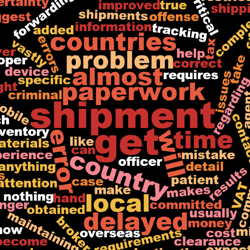|
REGISTRATION REQUIRED
exhibiting 101

Get the Show on the Road
Avoid transportation-related snafus before and after your next show by following these shipping tips.
Although I had a shipping disaster at my very first show, I was lucky that my company's long-term transportation broker took me under his wing and bailed me out. After I dodged the bullet of being fired, I decided to learn everything I could about exhibit shipping. Since then, I've asked lots of questions of industry pros about how things really work in exhibit shipping, and I even became an agent for a shipping company to learn how to avoid common pitfalls.
Whether or not you manage or delegate the logistics of moving your exhibit freight, you still need to understand the shipping process because your company relies on you to get your show on the road – and your career likely depends on it. The following lessons represent some of the most valuable advice I've received over the years regarding the transportation industry. Take these lessons to heart, and they will help you shape up so you can ship out just about anything with confidence. Pick the Proper Carrier Shipping exhibit materials to trade show venues is different than shipping anything anywhere else, in part because of the number, fragility, and size of the packages. The logistics of coordinating the shipping and arrival times to meet show deadlines, filling out all the shipping and material-handling paperwork, and managing the material-handling process further complicate the issue. Because of this, the first question to ask a potential carrier is what percentage of the company's sales come from trade show exhibit shipments. I usually steer clear of a company that doesn't derive at least 50 percent of its sales from the trade show industry. Look for a carrier that has a dedicated trade show division. Request a written copy of the carrier's procedures for problem solving in the event of lost or missing freight, damage, delays, etc. And ask about your shipping agent's availability in case of emergency. Transportation carriers' agents, brokers, and dispatchers should be available 24 hours a day, seven days a week. Personally, I won't ship with a company with which I don't have a "call anytime" cellphone number for somebody at the vice-president level. Additionally, ask any potential carriers to supply a few long-time exhibitor customers as references. Then contact these references and ask them how long they have been shipping with the carrier; the size, type, and frequency of their trade show shipments; how closely the carrier's quotes match the final invoices; what surprises (good or bad) they've experienced; if they have an assigned contact within the shipping company; and how the company has handled any problems or mix-ups. Choosing your carrier is a mission-critical decision, so make sure you have all the information before you commit. Once you find a company you trust, stick with it. The stronger – and longer – your relationship, the more likely company reps are to go that extra mile to help when disaster strikes. Provide Adequate Information For each show, compile a spreadsheet of the exhibit components, graphics, carpet, products, equipment, literature, giveaways, and supplies that need to be shipped. Add columns for the quantity of each, how they will be packed (crated, in cases, loose boxes, or palletized), and their dimensions and estimated weight. If you are shipping equipment or products that have serial numbers, it is a good idea to note these numbers on the inventory in case something is lost or stolen and an insurance claim needs to be filed. Provide this list to your carrier so it can deliver an accurate quote and reserve your shipping space on a truck or plane. Your transportation carrier will also need to know the full name of the show (not just the acronym), your booth number, the show dates, your move-in and move-out dates, and whether these dates are targeted. Indicate if you will need special equipment, such as lift-gate trucks, stacking bars, J-bars, pallet jacks, dollies, and/or moving pads. Tell your carrier whether a dock is available for loading, if there will be pickups or deliveries at multiple locations, and if you have pallets of multiple pieces that you don't want depalletized. Determine Your Destination Exhibit managers typically have two options for where to ship exhibits: 1) to an advance warehouse, which typically includes 30 days of warehouse storage courtesy of the trade show's general services contractor (GSC), or 2) directly to the show site. Shipping to the advance warehouse gets your freight on the show floor before direct-to-show shipments begin unloading. Advance shipments also save you money on marshalling yard wait-time fees storage expenses. One limitation of using the advance warehouse, though, is that it does not accept pad-wrapped freight. Shipping to the advance warehouse also requires additional labor and equipment, which may raise your material-handling cost and create more risk for damage or loss during handling. Another risk is that exhibit materials are not always stored in an actual warehouse; they may be stored in trailers and are not always secure. Shipping direct to site allows you to avoid these risks. However, with direct-to-site shipments the exact time your shipment will unload is unpredictable, based on the check-in time of your truck, efficiency of the marshaling process, and availability of docks with direct access to your booth space. Depending on how late in the day your targeted inbound is scheduled, you may run out of room around your booth space if neighboring exhibitors' freight arrives first. You can also split your shipment and send some items to the advance warehouse and some direct to site. Some exhibitors ship their carpet, pad, and exhibit to the advance warehouse to gain the extra day(s) of setup time (ideally on straight time rather than overtime), and ship their product direct to site if they won't need it until the exhibit build is completed. Don't Miss Deadlines Ensure your transportation team knows the last day to unload at the advance warehouse and the time of the targeted direct-to-site shipments. If your carrier misses the direct-to-site inbound deadline, the truck may be sent to the end of the line to unload – and incur a financial penalty or be unloaded at overtime rates, plus a penalty. The time the freight arrives at the booth can also affect installation costs; if it doesn't arrive in time for your setup crew to work on straight time, you may have to pay overtime rates for your labor. So include a margin of error in your shipping schedule if possible, as myriad hazards can delay your shipment, such as a mechanical failure on a plane or truck, a weather-related delay, or a truck driver's family emergency. Discuss the worst-case scenarios with your carrier and pad an extra day into your schedule. Anticipate All Expenses Transportation accounts for roughly 10 percent of a company's overall trade show budget. But transportation can also affect other budget categories, such as material-handling and installation costs. So talk with your transportation carrier to make sure you are proactively budgeting for any direct and indirect charges. Material-handling rates vary based on the type of freight and its final destination. For example, there are usually different rates for floor-loaded, crated/palletized freight sent to the advance warehouse via common carrier versus similar freight sent to show site. Higher rates may apply to similar freight delivered direct to show site by a specialized airfrieght or van line carrier. You can also incur special-handling charges for loads requiring additional time, labor, or equipment to unload, such as pad-wrapped loads, stacked shipments, and carpet-and-pad-only loads. Furthermore, handling rates increase for constricted-piece unloading, designated-piece unloading, ground unloading, and shipments that don't have individual bills of lading. Label and Submit Paperwork The bill of lading establishes the terms of the contract between the shipper and its transportation company. But at the end of the show, the uniform material handling agreement (UMHA) must be completed and turned in when your freight is ready to load. This grants the GSC the authority to turn your freight over to the carrier noted on the UMHA. Without it, your freight may be "forced" to the GSC's warehouse for storage pending further instruction, or shipped via the official shipping contractor at nondiscounted rates. Additionally, many problems are caused by old labels accidentally left on exhibit properties. Always check your shipment twice to make sure you've removed all old labels from the last shipment and placed two new labels on each piece of freight, just in case one falls off. And be sure the destination on your labels is correct for each leg of the trip. Confirm Your Coverage What would happen if your exhibit shipment was lost, stolen, damaged, or delayed? In most cases, your transportation carrier will only provide minimal valuation called "released value," which usually ranges from 30 to 60 cents per pound. If you need to cover the replacement value of your shipment the entire time it in transit, purchase additional valuation from carriers in $1,000 increments. However, the most economical way to cover your shipment is to purchase "door-to-door" all-risk insurance as a rider to your corporate insurance policy. Work with your company's risk-management department to determine the replacement value of your entire shipment and how much risk you want to assume with your deductible. Ultimately, you incur some degree of risk every time you ship your freight to a show. Even if you are fully insured for every penny of the shipment's value, losing it will undoubtedly cause stress and anxiety at the least, and could have serious repercussions for your company if you're forced to exhibit, well, without an exhibit. But these valuable lessons will help you keep your program in ship shape, while providing you a little peace of mind in the process. E  Candy Adams
Candy AdamsCTSM, CEM, CMP, CMM "The Booth Mom," is an independent exhibit project manager, trainer, speaker, consultant, and an Exhibitor Conference faculty member. CandyAdams@BoothMom.com
|
|
|
||||||||||||||||||||||||||||
|
|
||||||||||||||||||||||||||||
|
TOPICS Measurement & Budgeting Planning & Execution Marketing & Promotion Events & Venues Personal & Career Exhibits & Experiences International Exhibiting Resources for Rookies Research & Resources |
MAGAZINE Subscribe Today! Renew Subscription Update Address Digital Downloads Newsletters Advertise |
FIND IT Exhibit Producers Products & Services All Companies Get Listed |
EXHIBITORLIVE Sessions Exhibit Hall Exhibit at the Show Registration |
ETRAK Sessions Certification F.A.Q. Registration |
EDUCATION WEEK Overview Sessions Hotel Registration |
CERTIFICATION The Program Steps to Certification Faculty and Staff Enroll in CTSM Submit Quiz Answers My CTSM |
AWARDS Exhibit Design Awards Portable/Modular Awards Corporate Event Awards Centers of Excellence |
NEWS Associations/Press Awards Company News International New Products People Shows & Events Venues & Destinations EXHIBITOR News |
||||||||||||||||||||
|
||||||||||||||||||||||||||||






